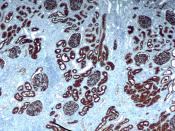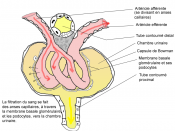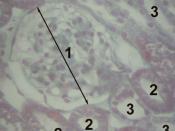a brief review of human excretion,absorption etc. "hit all the points", "nice work"
Excretion and Elimination of
Toxicants and their MetabolitesExcretion and Elimination of
Toxicants and their Metabolites
The first topic that was covered by this chapter was the excretion of wastes by the Renal system. The first step that occurs in the kidney deals with the nephron, which is the functional unit of the kidney. In the glomerulus the formation of urine begins with the passive filtration of plasma through the pores that are found in the glomerulus. The plasma is forced through these pores by hydrostatic pressure. The only things that determines if a molecule will pass through the pores of the glomerulus is it's molecular weight. The lower the molecular weight, the easier it will pass through the pores. Another determining factor will be if a molecule is bound to a large molecule. If this is true then passage through the pores will be hindered by the size of the larger molecule.
Reabsorbtion of the many ions, minerals and other nutrients that escaped in the glomerular filtrate will need to be recovered.. Reabsorbtion begins in the tubules of the nephron. Anywhere from 65% to 90% of reabsorbtion occurs in these structures. Active reabsortion is used to recapture glucose, proteins, amino acids and other nutrients. Water and chloride ions are passively reabsorbed by the establishment of osmotic and electrochemical gradients. Both the Loop of Henley and collecting duct are used to establish these osmolar gradients. The tubule has a brush border that will absorb proteins and polypeptides through pinocytosis. These molecules are sometimes catabolised and converted into amino acids. and returned to the blood. Sometimes the accumulation of these proteins can lead to renal toxicity
A second process that occurs in the tubules is tubular secretion. This...


